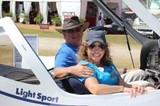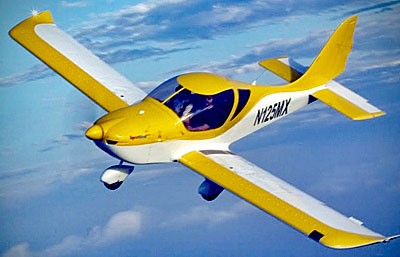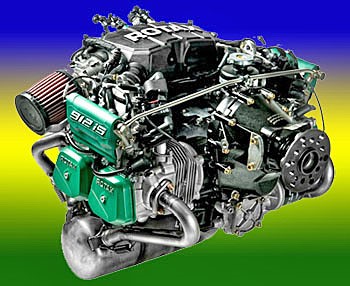Flight Training in a light sport aircraft! Evektor Harmony LSA Trainer, Dreams Come True LLC.
Do Light-Sport Aircraft Make Good Trainers? That Is the Question!
One of the controversies surrounding Light-Sport Aircraft has to do with that first word: “light.” Early on, one aircraft importer lobbied to remove the word as it was negatively viewed, he believed.
Article updated (5/17/19) with newly released video with Sunrise Aviation owner, Mike Church above.
Sunrise Aviation Flight School Operator using Evektor Aircraft
Indeed, outside of the LSA world, many pilots I’ve spoken to believe these aircraft are too lightly built to hold up in flight training, one of the most demanding of all flight activities. “Yes, an experienced pilot may love a LSA,” they may concede, “but these aircraft cannot hold up to regular flight instruction duty.” Enthusiasts may be biased but what would an actual flight school operator say?
To get it straight from the horse’s mouth, I inquired of Sunrise Aviation. This substantial flight school has for more than 40 years operated out of the very busy John Wayne airport in Orange County, California. They previously relied on Cessnas for primary flight instruction and hesitantly entered the LSA space with a single Evektor SportStar. How do they feel now, ten years later?
Evektor Aircraft Flight School Owner
Sunrise Aviation Evektor Flight Training Facility
photo by Stephen Trerotola
Sunrise was founded and is personally supervised by Michael Church, a national flight training authority, honored by the FAA as Safety Counselor of the Year and recognized as a Master Flight Instructor and Master Aerobatic Flight Instructor.
Church has logged more than 11,000 hours of flight instruction given. What does he have to say about his experience with LSA?
“It was obvious that LSA was going to potentially revolutionize flight training by reducing expense.” Mike acquired his first Evektor in 2009, only five years after LSA burst on the aviation scene. Sunrise trains to all levels, even including aerobatics, so pilots that start in LSA may transition later.
Mike wondered how Sunrise students would proceed after primary training in LSA and afterward moving to larger aircraft. “SportStar is perfect. It is a great training vehicle and the transition to larger aircraft seems to be very straightforward.”
Mike amplified, “Flight instructors like it because it is really a great training airplane. The best trainers are light, small, maneuverable, frisky. The quicker the airplane makes the student aware of a problem, the quicker the student will recognize a maneuver that didn’t look right, the easier it is to get the student involved with fixing the problem. From the flight instructor’s view, it simply makes the job easier.”
Any owner can get jazzed about an airplane he or she recently bought. The excitement of a new purchase can overwhelm the pragmatic aspects of longer-term ownership. Here are Mike Church’s thoughts six years ago, in 2013. Later on, we’ll update his perceptions.
“Cost of operation has proven to be the single biggest value.” That was very important to this businessman. He specified fuel use was so much lower than what his schools was used to with Cessna 150s and 172s. Since 1978 avgas has only gotten more expensive. Lower fuel cost seems obvious, perhaps, yet endurance of the airframe is one of the problems regular GA pilots note.
“Apparently the low inertia and light weight means they don’t break very much,” Mike observed. In just four years, he reported reaching engine overhaul in two airplanes, logging more than 2,000 hours in each. “We had very few problems.” Way back then, Mike felt, “This is the training airplane to which Sunrise is now committed.”
So he liked Evektor. What about the Rotax engine those models use?
Mike noted that his earlier aircraft went through four overhauls of their Lycoming engines. He became very confident with them. In 2013, Sunrise was still acquiring time with Rotax and Mike considered the trial ongoing but added, “to date, the Rotax engines have been remarkably trouble free.”
And now? In the six years since, he has become an even bigger advocate of Rotax powerplants. By January of 2019, he reported, “We now have a fleet of five Evektor [both SportStar and Harmony models], and we have accumulated more than 18,000 hours of experience on the airframes and engines.”
“I can say now with great assurance that the Rotax has proved to be a remarkable piece of machinery. Low cost of operation. Low cost of maintenance. I’m a fan!”
Moving from Rotax to other engines means students must learn some new tasks, such as operating mixture control, but he concluded, “This is relatively simple [training] stuff to teach.”
Evektor Aircraft Engines - How about Mechanics?
Rotax 912 Engine Powering Evektor line of lightsport aircraft.
A flight school owner might be expected to be positive about purchase he made. What happens when Sunrise mechanics are asked about their views of Evektor airframes and Rotax powerplants?
Sunrise mechanic Matt Wilderman is an A&P with Inspection Authorization. He relates experience since 2009.
“I’ve never worked with an airplane that demanded so little maintenance. It’s mostly been tires and brakes. We’ve had no major airframe issues and very minor engine issues.” He enthusiastically added, “If you keep on top of them, they’ve been fantastically reliable, more so than any other airplane I’ve worked on.”
How does Matt feel about Rotax? “They’ve also been fantastic. I’ve never worked with a better aircraft engine.” To clarify, Matt added, “We change the spark plugs, the oil, and the filters every 50 hours. Even running avgas we’ve had no problems with leading that some people have reported. In 2,000 hours we replaced one small spring on the sprague clutch; that’s it.”
“We’ve had no lubrication issues, no ignition issues. I had questions at first, but despite hard use by students, the engines have held up exceptionally well. Most squawks that I’ve received have been indicators; it always seems to be the sensor but today even those problems appear to be resolved.”
“The airframes are so light that you don’t see a lot of wear,” Matt continued, and in so saying he turns the “light” problem upside down to become a positive. “They just haven’t been breaking. I have nothing but praise for the whole LSA program.”
What Do Instructors Think about the Evektor light sport aircraft.
Instructor don’t own the equipment nor must they repair it. Here’s a sampling of what various Sunrise instructors say.
“SportStar is excellent for training. It has nice control responses.”
“My students love flying this [Evektor]. It’s so easy to fly.” They relate the students are comfortable in the airplane.
“Visibility absolutely unrestricted” and their students like that. “The view is amazing.”
“The climb performance that Evektor provides us is incredible.”
Evektor has proven very cost effective. “You only spend about twenty bucks on fuel,” said another CFI, referring to the cost of providing a flight lesson.
When a Master CFI and owner/operator of a Part 141 flight school talks this way after a decade of experience, it would seem to carry more heft than your average Private Pilot. After building 18,000 hours of total time on a fleet of five Evektor LSA over 10 years experience, Sunrise Aviation remains committed to Evektor Light-Sport Aircraft for primary flight training.
Dreams Come True Aviation

Dreams Come True (DCT)
Aviation LLC,
Steve & Debbie Minnich
EMAIL
181 Kiser Drive
Tipp City, OH
45371
937-266-9303
1-800-883-1897
LSRM & iRMT



